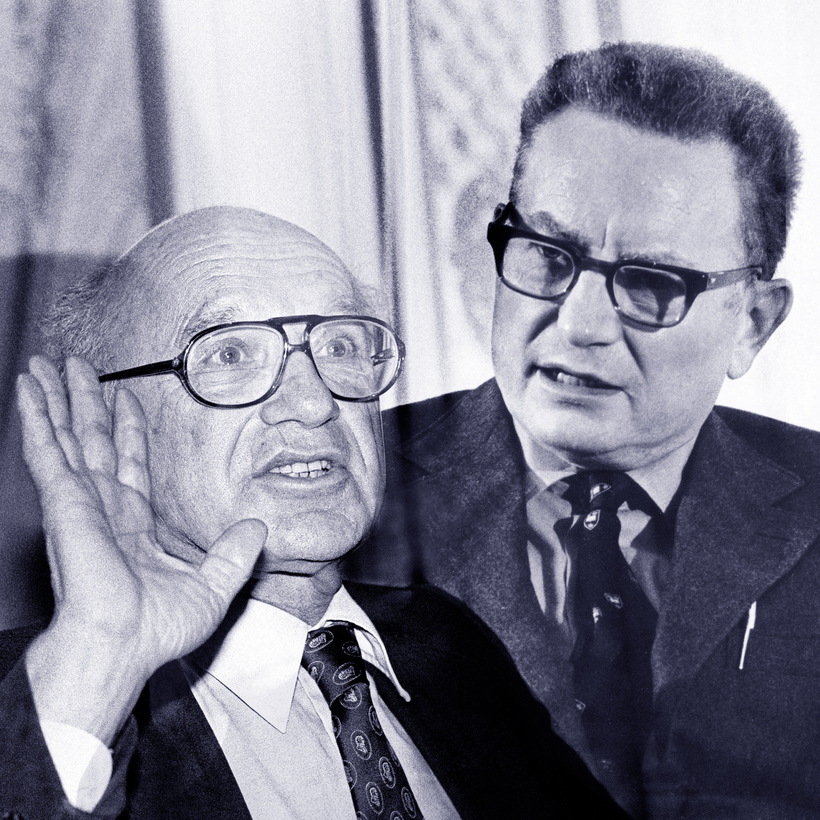Two Jewish guys, born three years apart, enjoy near identical upbringings. It is as if they were identical twins separated at birth—both brought up without much wealth; both exceptionally bright lads, who sat in the same economics class at the University of Chicago. Both witnessed at first hand the horrors of the Great Depression and watched side by side as Franklin Roosevelt struggled to put millions of Americans back to work. Both eventually found great success, wealth, and world fame as economists, and both were awarded Nobel Prizes.
Yet Paul Samuelson and Milton Friedman were polar opposites. Early on in his life, Samuelson turned left, wholeheartedly embraced the new economics of Keynesianism, and made himself a multi-millionaire by writing a textbook simply called Economics that became the bible for all but a small handful of economists in denial.
Along the way, thanks to anti-Semitism at Harvard, he transformed the Massachusetts Institute of Technology (M.I.T.) from a modest engineering college into one of the world’s leading research institutions.
Friedman, meanwhile, turned right, set out to personally contradict and turn back Keynes’s legacy, wrote backwoods senator Barry Goldwater’s free-market economic policies, advised Richard Nixon and Chile’s murderous military junta, and provided the intellectual reasoning that led the once conservative G.O.P. to become overwhelmed by the libertarian ideas of the Tea Party, with its angry mob of supporters railing against the very notion of government and mounting an absurd invasion of the Capitol.
What caused these two otherwise reasonable men, once close buddies, to become the bitterest of frenemies? How could men with such similar backgrounds and experiences find themselves pitched against each other at every turn?
Real Housewives Meets Game of Thrones
Although both were devoted to the freedoms of speech and thought, their violent disagreement wasn’t over what the other did but what he believed. They went to their graves insisting that the other was not just misinformed but totally, utterly, and completely wrong.
When Encylopaedia Britannica asked Friedman, not Samuelson, to revise its entry on Keynes, Samuelson wrote to his rival that his take on Keynes’s revolutionary General Theory was a travesty of what Keynes thought. It was “inadequate” and “not worthy of you,” Samuelson wrote, and he suggested Friedman re-write the essay. But the revised entry still did not please Samuelson, who offered revisions of his own. Friedman snapped back that Samuelson was “protesting much too much.”
But perhaps Samuelson’s sharpest blow came in 2007, a year after Friedman’s demise, in an interview with Karen Horn for her book Roads to Wisdom. “Friedman never made a mistake in his whole life,” he said. “That’s remarkable, isn’t it?”
Samuelson blamed Friedman’s high I.Q., which he said gave Friedman the confidence to ignore all criticism, a facet of his rival’s personality Samuelson considered “a tragedy when somebody really takes the wrong train in life.” As for Friedman’s original contribution to conservative thinking, Samuelson was dismissive. “Had Milton never blown his horn, the rightward shift would have happened anyway,” he said.
Economics has often been described as “the dismal science,” but as the story of Samuelson and Friedman’s bitter enmity shows, it is anything but. Debates over economics combine the heartfelt bitchiness of The Real Housewives of New Jersey with the high-stakes life-or-death power grabs of Game of Thrones.
The vitriol of the Samuelson-Friedman feud can be traced to the first great left-right battle in economics, in 1931, between John Maynard Keynes and Friedrich Hayek, who was hired by Lionel Robbins, the ambitious young head of the London School of Economics, as a hitman to stop Keynes in his tracks. That unlikely duel by learned journal was so bitterly fought that Arthur Pigou, a professor of political economy at the University of Cambridge, begged the two men to stop clawing at each other “like Kilkenny cats.”
Since then, neither side in economics has given any quarter to the other. During the 30 years the Keynesians ruled the roost, anyone who dared criticize the Blessed Maynard was dismissed as mad or, worse, was totally ignored.
But their smug smiles turned to tears when, in the 1970s, Keynesianism could not explain “stagflation”—the simultaneous appearance of high inflation with a stagnant economy. It was then the turn of conservative economists to smirk and sneer at their adversaries’ discomfort.
When Keynes’s reputation was restored in the aftermath of the financial freeze of 2008, and again in the wake of the coronavirus shutdown, Keynesians once again reveled in their opponents’ failure to come up with a plausible alternative to printing money.
To their credit, Samuelson and Friedman tried to maintain a modicum of good manners when criticizing each other in public. But behind closed doors, the gloves were off. The standard of public debate has suffered as a result of the unforgiving schism between left and right in economics. But for a biographer, such disgracefully bad grace makes for great tales of passionate rivalry and cold revenge.
Nicholas Wapshott’s Samuelson Friedman: The Battle over the Free Market and its precursor, Keynes Hayek: The Clash That Defined Modern Economics are published by W. W. Norton

